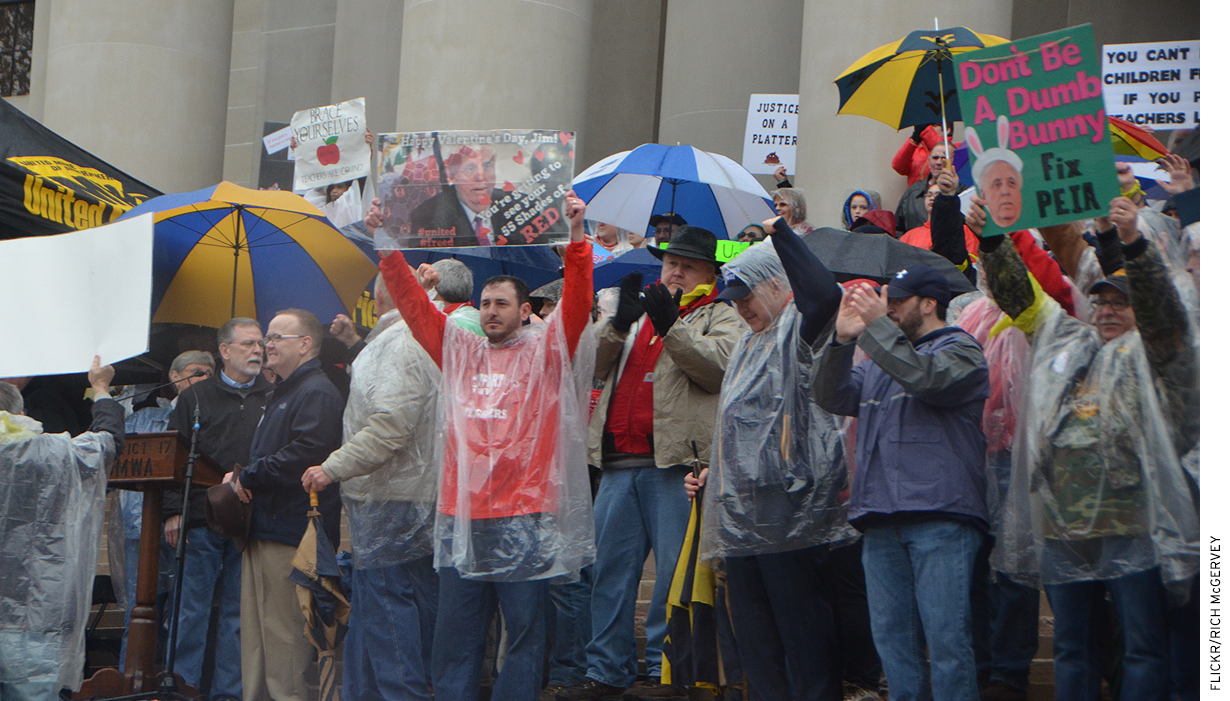
The recent teacher walkouts in West Virginia, Oklahoma, and Kentucky have not only been remarkable for their scope and success, but have also rapidly reshuffled the educational debates. In the weeks before West Virginia’s teachers walked out, talk of teachers revolved around how badly the Supreme Court’s impending decision in Janus might hurt the unions. Now, at least temporarily, the narrative has totally flipped. What to make of all this? Well, as I’ve talked to various advocates, journalists, and officials, at least five thoughts keep coming to mind:
1. Teachers are immensely sympathetic actors. For all the gibes, harsh rhetoric of the accountability era, and tsk-tsk’ing occasioned by polls in which people say they don’t want their kids to be teachers, the reality is that people really like teachers. In surveys, no matter how much talk there is about “failing” schools and problems with tenure, teachers are trusted and popular. For most parents, the primary source of information about their school is their child’s teacher. As we’re seeing, and as I noted back in The Cage-Busting Teacher, that reservoir of goodwill makes teachers pretty formidable actors—much more than some observers might imagine.
2. The Trump era has made it tougher for GOP officials to plead “fiscal restraint.” Since Trump’s election, there’s been a lot of attention to the struggles of working- and middle-class Americans in places like West Virginia, Kentucky, and Oklahoma. Meanwhile, last year, Republicans in Washington passed a trillion-dollar tax cut for businesses. And, just a few weeks ago, Washington Republicans blew up the federal budget caps—largely so that they could boost funding for the Pentagon. Against this backdrop, it’s tough for Republican governors to insist, “Well, sure, our party’s leaders in Washington can find huge dollars for tax cuts and defense, but we can’t afford a pay raise for struggling, hard-working teachers.”
3. Twenty-first century school reform has a big role in bringing us to this point. A mantra for reformers since No Child Left Behind has been the critical role of teachers. In pursuing this agenda, would-be reformers emphasized the need to overhaul teacher evaluation and tenure, retool teacher preparation, and place a substantial weight on reading and math scores in judging teacher effectiveness. This was all sensible enough (aside from an increasingly unhinged fascination with reading and math scores), but it was pursued with rhetoric that not infrequently veered into broad condemnations of the nation’s schools and teachers—and which failed to take serious the need to ensure that any changes were equally attentive to rewarding professionalism and honoring excellence. Along the way, teachers came to look and feel like targets, rather than beneficiaries, of “school reform,” which may be why bread-and-butter demands from teachers are ascending as the guts of Bush-Obama school reform are sinking to the bottom of the “discarded school reform” sea.
4. Teachers have picked up tremendous momentum. The textbook case for deflating a public-sector strike may have been Ronald Reagan’s response to the 1981 air traffic controllers strike. Readers of a certain age will recall that, early in his presidency, Reagan was confronted with a strike by the nation’s air traffic controllers. It was presumed that they had Reagan over a barrel—and that their success would inspire imitators. Instead, shockingly, Reagan fired the striking controllers. The enormous cost to those who lost their jobs prompted a lot of second-guessing among public employees and deterred would-be imitators. Developments in West Virginia, and now Oklahoma, have taken a different path. In West Virginia, superintendents shuttered districts, ensuring that teachers wouldn’t run afoul of the state’s “no striking” law or lose salary. Oklahoma’s district leaders have acted similarly. Meanwhile, faced with popular support for the teachers, state officials have avoided harsh words and worked to meet their demands. The good press, lack of consequences, and big wins seem primed to inspire imitators.
5. There’s a huge opportunity here . . . if teachers and state leaders can seize it. As I see it, good teachers are ridiculously underpaid—and I’d like to see teachers get a solid raise across the board. But there’s a problem with simply funneling those dollars into existing arrangements because school systems spend a lot of money in ways that don’t make a lot of sense. We have exceptionally expensive benefit systems that mean a big chunk of school funding is going to pay retirees rather than today’s teachers. Schools have added non-instructional staff at a pace that has massively outstripped student enrollment. In recent years, would-be reformers have goofed when imposing new teacher-evaluation systems while failing to identify or do right by all the teachers who play a critical role in their schools and classrooms. Now, we have another opportunity to tackle this challenge—to boost teacher pay and make substantial new investments in schooling while rethinking benefits systems, teacher compensation, and staffing. Doing so would be good for teachers and students, appealing for taxpayers, and make it easier to sustain bipartisan support for new spending. Now, admittedly, in recent years, we’ve not been great at seizing win-win opportunities when it comes to schooling—but here’s hoping.
It’s hard to know how these things will go. Ten weeks ago, hardly anyone saw West Virginia and Oklahoma coming. Will they trigger a national wave of imitators? Will the narrative shift again in the aftermath of a Janus decision that goes against the unions? Or might these simply be more glimpses of what’s ahead as the school-reform pendulum swings away from the Bush-Obama era? Time will tell.
— Frederick Hess
Frederick Hess is director of education policy studies at AEI and an executive editor at Education Next.
This post originally appeared on Rick Hess Straight Up.


